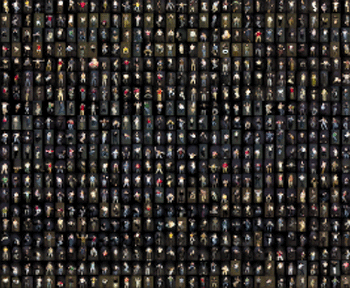Rafael Lozano-Hemmer’s interactive experience
Relational architecture, technological theater, 21st century art. Call it what you want, but the interactive, participatory, and dynamic works of Rafael Lozano-Hemmer are much more alive and connective than any theoretical reduction can convey.
Not that the terms are wholly inaccurate. The first is the artist’s own language, there’s an undeniable performative aspect to the work, and it does utilize 21st century technologies. But trying to classify it fails to acknowledge the subversive bent of this digital devil’s advocate.
Lozano-Hemmer’s artwork incorporates data networks, robotics, sensors, mobile, and custom made devices to create new social and cultural experiences where virtual and physical realities interact. In all of his work, audience participation is a pre-requisite, the response it produces becomes part of the art. His award-winning installations have won praise for creating platforms for group experience, rather than the solitary individual interfaces typical of galleries and communication technologies alike. He has worked with many large-scale projects, augmenting buildings and sites around the world with what he calls “artificial memory” by adding aural and visual elements that challenge and expand historical, social, and cultural contexts. He is working on a new project in Mexico with 500 light bulbs in a derelict space, which will map out heartbeats of people passing by, creating patterns of flashing light. Architectural interventions, interactive portraits, surveillance and other detection systems—these are the concerns and tools of an artist who sees the conundrum of electronic technologies, and uses them to reflect users back in their networked image.
“In the gallery it’s the status of the artwork that matters as opposed to social interpretation,” explained the artist when asked how he approaches making work for public versus private spaces. “Typically we go to a gallery or museum to be inspired, to understand. It’s a silly reversal, simplistic really. From Duchamp onwards we’ve been dealing with the idea that it is the observation that makes the artwork. With interactive art the alternate relation is established. The art observes the public, listening, sensing, expecting them to do something. The technology is predatory.”
His upcoming exhibition features three intimate installations, “Standards and Double Standards” (2004), “Third Person” (2006), and the premiere of “Close Up.” The latter two are part of the artist’s “Shadow Box” series, in which passers-by activate portraits in their own shadows. “Close Up” creates the viewer’s image with hundreds of tiny videos of other people who have recently looked at the work. These videos are simultaneously triggered on approach, all turning toward the observer, who becomes the observed. In “Third Person” the interactive display draws the viewer’s portrait in real time with hundreds of tiny words conjugated in the third person in English and Spanish. The U.S. premiere of “Standards and Double Standards,” originally shown at Art Basel 2004, turns viewers into targets of electronic surveillance. A dozen belt buckles hanging at waist height turn their buckles to face gallery visitors. As more people enter the space, their presence affects the actions of the entire group of belts, creating chaotic patterns of interference. While the seatbelts are empty and the cameras invisible, the condition of surveillance is expressed nonetheless—as an unpredictable networked system.
Lozano-Hemmer hides the code and wires, flips the perspective, and shifts the intent of the technologies he uses to shake out new experience and meaning. But he doesn’t advocate any single possibility or tactic for interacting with his work.
“Its not pedagogical. It responds according to your input. [You’re] capturing a process whose outcome you don’t really control. It’s possible for the outcome to surprise the designer, for there to be a very different use for your work than you anticipated.”
Recently, the Mexican-born Canadian artist’s works have been acquired by several prestigious contemporary art collections in Europe, Mexico, and the U.S.—including MoMA—a phenomenon he finds ironic, but essential.
“My works are ephemeral interventions in public space,” said Lozano-Hemmer. I like to think of it in terms of preservation versus perpetration. The first always makes me think of mothballs and necrophilia; the latter recognizes the piece as a cultural act. But, the works can and should be included precisely because they can refresh themselves. In interactive art, the display is different depending on the people, and how they approach it. It changes it, instills it with aura, uniqueness. It can have an immediacy that keeps it new.”
This exhibition is part of Celebrate Mexico Now, a citywide festival of contemporary Mexican art and culture. Mexiconowfestival.org
gaycitynews.com



































